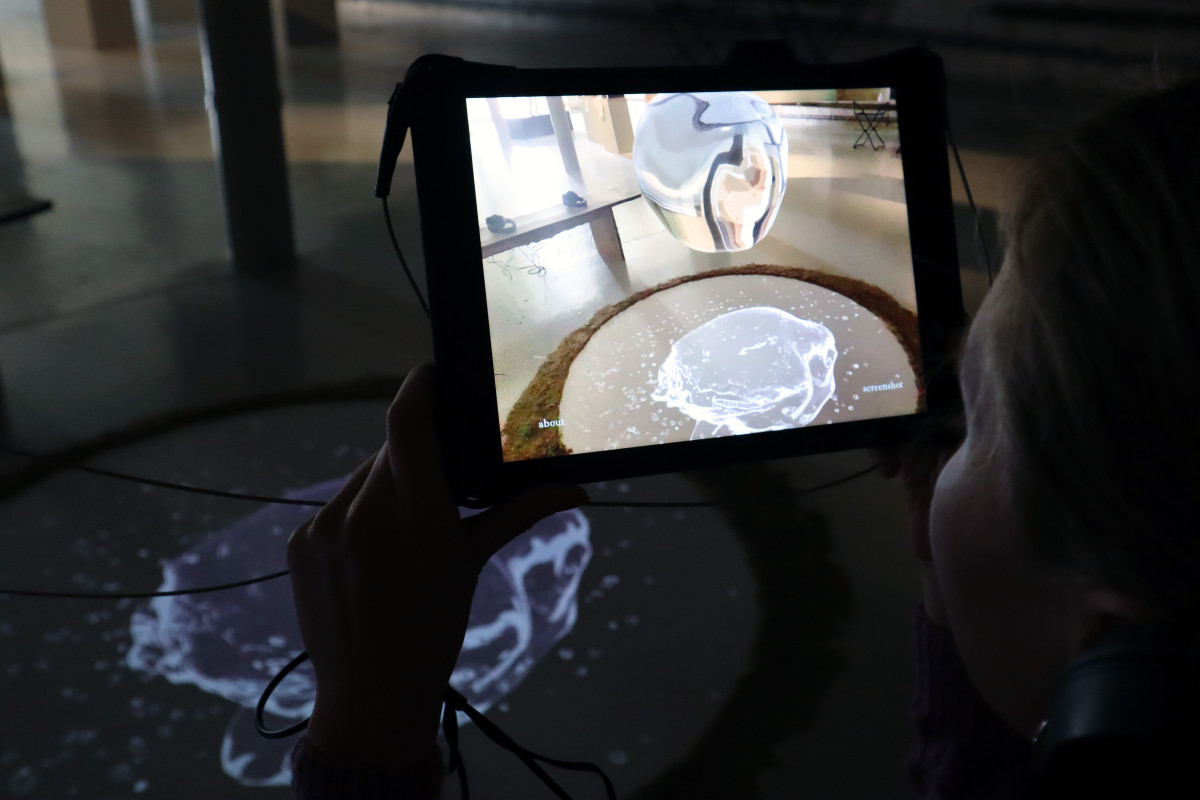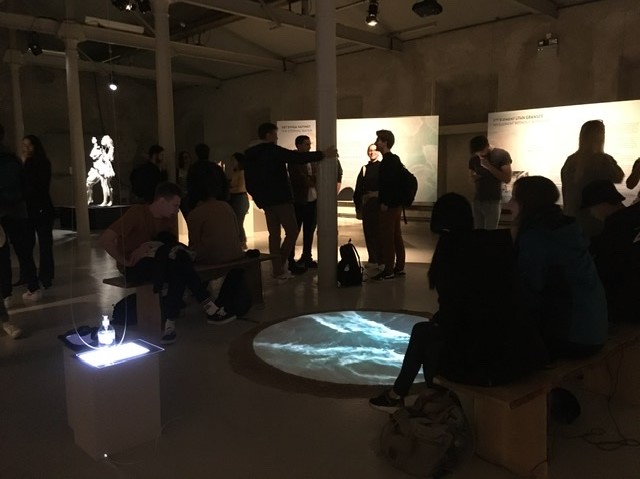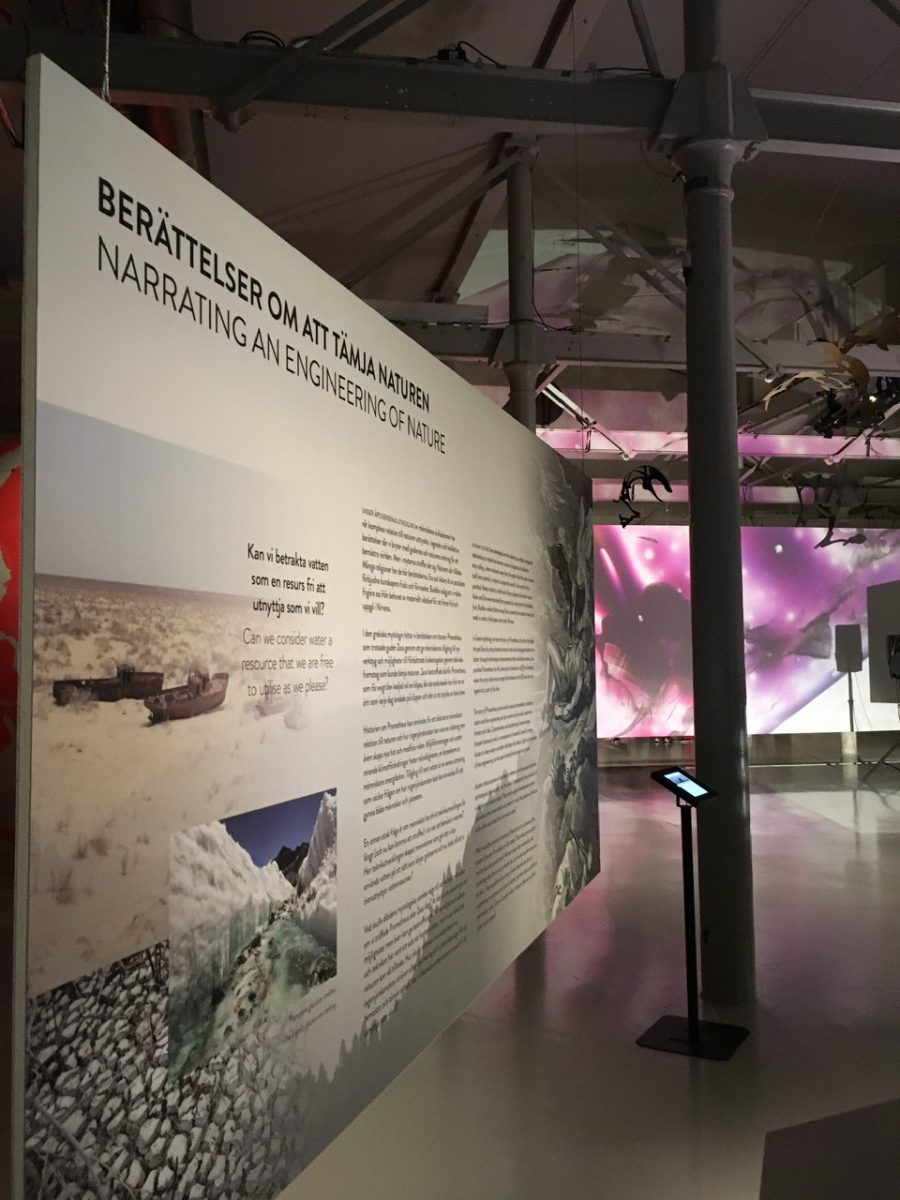Text by Katarina Larsen
The exhibition hall is located in an old industrial building in area of Lövholmen, near Liljeholmen in the south of Stockholm. Researchers from KTH working with the water theme included Katarina Larsen, David Nilsson and Timos Karpouzoglou. As a part of the interactive approach, we asked visitors about their relation to water and also challenged them to imagine what messages that they could hear if water itself was given a voice or legal rights. Some of the reflections received from visitors to the exhibition were really thought provoking.
The water component of the Symbiosis exhibition was developed in collaboration with the art institution Färgfabriken and the Stockholm based artist Åsa Cederqvist. The artistic work and collaborative dialogues created ideas for how to communicate different types of water narratives, through texts, images and interactive activities during the exhibition. The art work developed by Åsa was entitled “The Essence” giving water a voice of itself. This was done through an art installation using augmented reality (AR) to create a visual 3D image of a drop of water floating above the floor in the factory of Färgfabriken when visitors looked through the lens of a digital screen.

The visitors could also hear the voice of this water spirit through headphones and speakers and were asked what they think the water spirit would tell them. Some of the answers from the visitors expressed a sense of guilt (that we have not taken care of nature like we should have) but also narratives revealing a strong connection with water and nature. Other reflections dealt with idea of control of nature, that there is a struggle between humans and nature and water as a precondition for life on earth.
“I have existed for millions of years and kept plants and animals alive and developed new life forms. I will always survive and find new life forms. Doesn’t humanity want to be a part of that also?
“Look at me angrily, maybe punch me”
“Get a grip!”
“Take good care of me, or else….”
“It’s OK, I love you anyway”
“I have been inside Björn Borg’s stomach”
“Show some respect for my spirit and do not take me for granted!”
Other responses expressed that it would be interesting to take part of the water’s life perspective, both historically and thoughts about the future and how we can we coexist in the best possible way.
We also invited policymakers, engineers and other local actors from the Stockholm area to a series of workshops to discuss their experiences from existing urban water infrastructures and views on future ways to manage systems and infrastructures in cities. The discussions took place in the exhibition hall hosting the exhibition “Symbiosis” curated by Färgfabriken.
During these workshops we wanted to have a dialogue with local politicians, policymakers as well as engineers who are managing existing critical infrastructures for water in Stockholm about their experiences and views on future ways to manage urban water infrastructures in cities. The dialogues also sparked discussions about what the term “infrastructure” actually means. Is it the pipes and wastewater treatment solutions that are in place today? Or does it also include, parks, and other green infrastructures in urban areas that can function as buffer zones for extreme rainfall to manage overflooded existing systems? What are the prospects of different types of nature-based solutions that will make use of circular solutions in the design of future urban systems?

The workshop participants expressed that they appreciated the workshop initiative also for the opportunity to connect with other local actors being involved in managing different aspects of water in Stockholm. Some comments from participants were that “we should use art more often to communicate” and that working with water requires dialogues between different types of actors to manage cross-cutting aspects of water. Water in different forms are crossing boundaries between municipalities as well as internationally and requires coordination and communication between actors representing a broad range of competences. The participants were also asked to reflect upon what factors that can be drivers for change with a 50-year horizon. Some of the conclusions outline future challenges of different kinds:
- The waste water systems are, to a large extent, made invisible to the users. As a consequence, they have disrupted the cyclic thinking for water management and treatment. As long as they are working – they are silent.
- Even if the systems are among the best ones in the world, they are not optimal. We can increase the circular systems, reduce the environmental impact and use resources better.
- Future climate change requires preparing for flooding in urban areas. This aspect was highlighted as highly likely by participants to influence a change in managing water supply in the Stockholm region within 50 years.
The workshop participants were also asked to reflect on what measures they thought would be acceptable for consumers. The answers showed that measures such as using rainwater to flush toilets and allowing parks be flooded to act as a buffer zone were thought to be accepted by citizens. For us researchers from KTH working with developing the water theme in the exhibition this brings some important thoughts onboard for further discussions and studies. Since the work with developing the exhibition was carried out during the pandemic of 2020-21 we were also delighted to be able to organize these workshops on-site in the exhibition hall and create dialogues on how art and science can bring about novel ideas, reflect on circularity of systems, and explore what can happen if water itself is given a voice to talk about future challenges and possibilities for urban water infrastructures in Stockholm.

Links and additional material:
Symbiosis exhibition: https://fargfabriken.se/en/projects/symbiosis
Urban water imaginaries in exhibition – co-creative dialogues between science, art, and engineering (interview with Katarina Larsen in ABE school newsletter)
Visitors relations to water and their memories shared:
“It is euphoric to swim in the sea and be a part of the element for a while. At the same time, the power of waves and depth is extremely frightening. My stepfather drowned during a dive and it’s awful to imagine that situation, to drown and sink into the dark depths.”
“Drinking cold water that tastes like iron, in the countryside with my friend when we were small, after being out to play.”
“Water is what almost took my life on several occasions, but it is also what I can enjoy in everyday life. It is also my favorite drink although deep water is one of the few things I am afraid of. So a cycle, it gives and takes.”
“I sail and do a lot of boat riding so I have always felt safe on the water, even though I know that every time I am out by boat, the sea can kill me at any time. But I have learned to use the water and live with the water when I am out there. It is some kind of coexistence. I think the sea likes people to sail on it. Just like it likes the animals swimming inside it.”
“at an incredibly intense and warm and long concert where I was stuck in the middle completely without anything to drink, I got water from a total stranger and it was the best water I have ever had”
“Fishing trip with grandpa, herring and flounder”
 Text by Katarina Larsen, researcher at the Division of History of Science, Technology and Environment
Text by Katarina Larsen, researcher at the Division of History of Science, Technology and Environment

